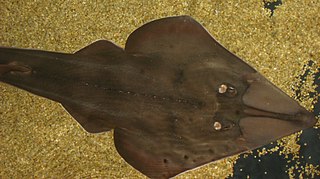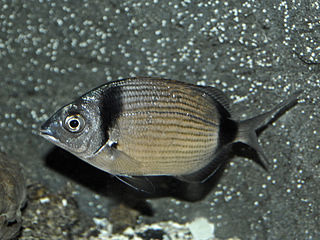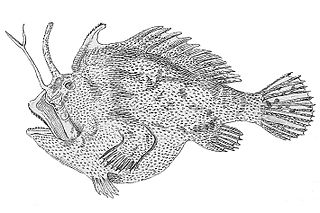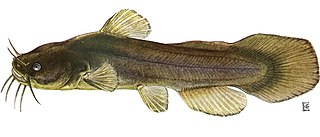 W
WThe African threadfish, also known as the Alexandria pompano, is a species of large marine fish in the jack family, Carangidae. The species is distributed along the coast of tropical Africa in the eastern Atlantic Ocean, extending to the Mediterranean Sea. Adults live predominantly in shallow waters shallower than 70 m deep, often forming small schools. The African threadfish is similar in appearance to the closely related and co-occurring African pompano, with the slightly concave shape of the species head profile the most definitive feature of the species. Like other members of the genus Alectis, the juveniles of the species have long trailing dorsal and anal fins. The African threadfish is of minor commercial importance, and is also considered to be a game fish.
 W
WThe black redhorse is a species of freshwater fish endemic to Ontario and the eastern half of the United States, where it lives in streams and small to medium rivers.
 W
WThe blackchin guitarfish is a species of cartilaginous fish in the family Rhinobatidae. It is native to the eastern Atlantic Ocean and the Mediterranean Sea. It is a bottom-dwelling fish feeding on crustaceans, other invertebrates and fish. The females give birth to live young. Its lifestyle makes it vulnerable to trawling and other fishing methods, populations seem to be declining and it is subject to intensive fishing pressure, with its fins being sold into the Asian market. The International Union for Conservation of Nature has assessed its conservation status as being "critically endangered".
 W
WThe blue sucker is a freshwater species of fish in the sucker family. The species has an average weight of 2-3 kilograms and an average length of 76 centimeters. The record length has been recorded at 102 centimeters.
 W
WThe bluntnose stingray or Say's stingray is a species of stingray in the family Dasyatidae, native to the coastal waters of the western Atlantic Ocean from the U.S. state of Massachusetts to Venezuela. It is a bottom-dwelling species that prefers sandy or muddy habitats 1–10 m (3.3–32.8 ft) deep, and is migratory in the northern portion of its range. Typically growing to 78 cm (31 in) across, the bluntnose stingray is characterized by a rhomboid pectoral fin disc with broadly rounded outer corners and an obtuse-angled snout. It has a whip-like tail with both an upper keel and a lower fin fold, and a line of small tubercles along the middle of its back.
 W
WAetomylaeus bovinus, also known as the bull ray, is a species of large stingray of the family Myliobatidae found around the coasts of Europe and Africa.
 W
WThe common shiner is a freshwater fish of the family Cyprinidae, found in North America. It ranges in length between 4 and 6 inches, although they can reach lengths of up to 8 inches.
 W
WThe common two-banded sea bream is a species of seabream belonging to the family Sparidae.
 W
WExoglossum maxillingua is an olive-green medium-sized minnow of North America with a distinguishing lower jaw. Isolated from all other minnows by its three-lobed lower jaw with the middle lobe sticking out like a tongue. The range of this species is from the St. Lawrence and Lake Ontario south into Virginia. It is listed as "threatened" in the Canadian province of Ontario, but may never have been common there as this is the most northerly of its range. It is found in running streams and seems to prefer clear, stony pools but not rapids. The distinctive mouth of the cutlips lets it feed on minuscule shellfish which it scrapes from rocks. Although molluscs appear to be its primary food, it also eats insect larvae and diatoms. An interesting feeding behavior of this species is "eye-picking" when food is scarce or competition is high. The Cutlips will pluck out the eyes of conspecifics or other species as a supplement to its regular diet. A nest builder, the cutlips male constructs a nest of stone, some of which are up to 18 inches across. Spawning happens late in spring when the male attempts to crowd females over its nest. The cutlips is not a popular bait species due to its softened coloration but it takes a hook without much difficulty and is favored in some areas as a choice panfish.
 W
WThe fallfish is a North American freshwater fish, a chub in the family Cyprinidae. The fallfish is the largest minnow species native to Eastern North America.
 W
WThe false scad, also known as the spotfin scad, ten-finned horse mackerel and yellow horse mackerel, is a species of medium-sized marine fish classified in the jack family Carangidae. The false scad is distributed throughout the tropical and temperate waters of the eastern Atlantic Ocean from Namibia in the south to Spain and throughout most of the Mediterranean in the north. The species has an atypical body form compared to other species of Caranx, and can be distinguished from these on its elongate 'scad-like' body shape alone. Distinguishing the species from members of Decapterus and Trachurus is more difficult, requiring detailed anatomical analysis. The false scad is known to grow to a length of 60 cm and a weight of 1 kg. The species lives both pelagically and demersally in continental shelf waters, ranging from depths of 15 to 200 m. It is a predatory fish, taking small fishes, crustaceans including euphausiids and shrimps, and cephalopods as its main prey, with significant dietary shifts as it ages. The false scad reaches sexual maturity at 2 years of age, with spawning occurring between April and July in shallow inshore waters, where the juveniles remain. The species is of major importance to fisheries throughout its range, but particularly from Morocco to Senegal, with annual catches ranging from 500 to 19000 t. The species is caught using trawls, seine nets and gill nets and sold fresh, frozen or salted.
 W
WThe banded killifish is a North American species of temperate freshwater killifish belonging to the genus Fundulus of the family Fundulidae. Its natural geographic range extends from Newfoundland to South Carolina, and west to Minnesota, including the Great Lakes drainages. This species is the only freshwater killifish found in the northeastern United States. While it is primarily a freshwater species, it can occasionally be found in brackish water.
 W
WKuiterichthys furcipilis, the rough anglerfish, is a species of frogfish endemic to the coastal waters of southern Australia and Tasmania. This species inhabits reefs and the ocean floor at depths from 10 to 240 metres. It grows to a length of 15 centimetres (5.9 in) TL.
 W
WThe Lusitanian cownose ray is a species of eagle ray found along the western coast of Africa and Mediterranean Sea. It is apparently very rare in the Mediterranean Sea, but is common in shallow waters off the western Africa.
 W
WThe northern hogsucker is a freshwater ray-finned fish belonging to the family Catostomidae, the suckers. It is native to the United States and Canada where it is found in streams and rivers. It prefers clear, fast-flowing water, where it can forage on the riverbed for crustaceans, mollusks, aquatic insects, algae and detritus. It turns over small pebbles and scrapes materials off rocks and sucks up the particles, and other species of fish sometimes station themselves downstream from its activities so as to garner disturbed food fragments. Breeding takes place on gravel bottoms in shallow riffles in late spring. This fish is susceptible to such man-made disturbances as channelization, sedimentation, pollution, and dam construction. However, it has a wide range and is a common species so the International Union for Conservation of Nature has rated its conservation status as being of "least concern".
 W
WOrcynopsis unicolor is a ray-finned, bony fish in the bonito tribe of the mackerel family (Scombridae). It occurs in the eastern Atlantic from southern Norway, where it is a vagrant, to Senegal, although it is not found in the seas around the Macaronesian Islands. It is also found in the Mediterranean Sea and extends to the Black Sea.
 W
WThe quillback, also known as the quillback carpsucker, is a type of freshwater fish of the sucker family widely distributed throughout North America. It is deeper-bodied than most suckers, leading to a carplike appearance. It can be distinguished from carp by the lack of barbels around the mouth. The quillback is long-lived, with age beyond 50 years documented.
 W
WThe rock bass, also known as the rock perch, goggle-eye, red eye, is a freshwater fish native to east-central North America. This red eyed creature is a species of freshwater fish in the sunfish family (Centrarchidae) of order Perciformes and can be distinguished from other similar species by the six spines in the anal fin.
 W
WThe round fantail stingray or round stingray is a poorly known species of stingray in the family Dasyatidae. It inhabits sandy, muddy, or rocky coastal habitats in the eastern Atlantic Ocean and the southern Mediterranean Sea. This dark-colored ray typically reaches a width of 1 m (3.3 ft), and can be identified by its nearly circular pectoral fin disk, short tail, and mostly bare skin. The round fantail stingray hunts for fishes and crustaceans on the sea floor, and exhibits an aplacental viviparous mode of reproduction. The International Union for Conservation of Nature (IUCN) does not yet have sufficient information to assess the conservation status of this species.
 W
WThe shorthead redhorse is a wide-ranging species in North America. The shorthead redhorse is native to central and eastern North America. However, its range has expanded to include areas like the Hudson estuary and Grayson County, Texas. It inhabits small to large rivers and lakes, and lives in the benthic zone. Shorthead redhorse feed on benthic invertebrates and can consume plant material from the benthic environment that it inhabits. When it spawns, shorthead redhorse move into more shallow streams and spawn over gravel or rocky shoals. They will also spawn in springs with swift moving water. The shorthead redhorse is important to humans because it is a game fish. It is also important to anglers because of its role in the ecosystem; it is prey for larger game fish such as northern pike and muskellunge.
 W
WThe spotfin frogfish, Antennatus nummifer, is a fish of the family Antennariidae, found in all subtropical oceans to depths of 300 m. It grows to 13 cm (5.1 in) in total length. This species can be found in the aquarium trade.
 W
WThe tadpole madtom is a species of fish in the family Ictaluridae. It is native to Canada and the United States.
 W
WThe white grouper is a species of marine ray-finned fish, a grouper from the subfamily Epinephelinae which is part of the family Serranidae, which also includes the anthias and sea basses. The white grouper is found in the subtropical eastern Atlantic Ocean and the southern Mediterranean Sea.